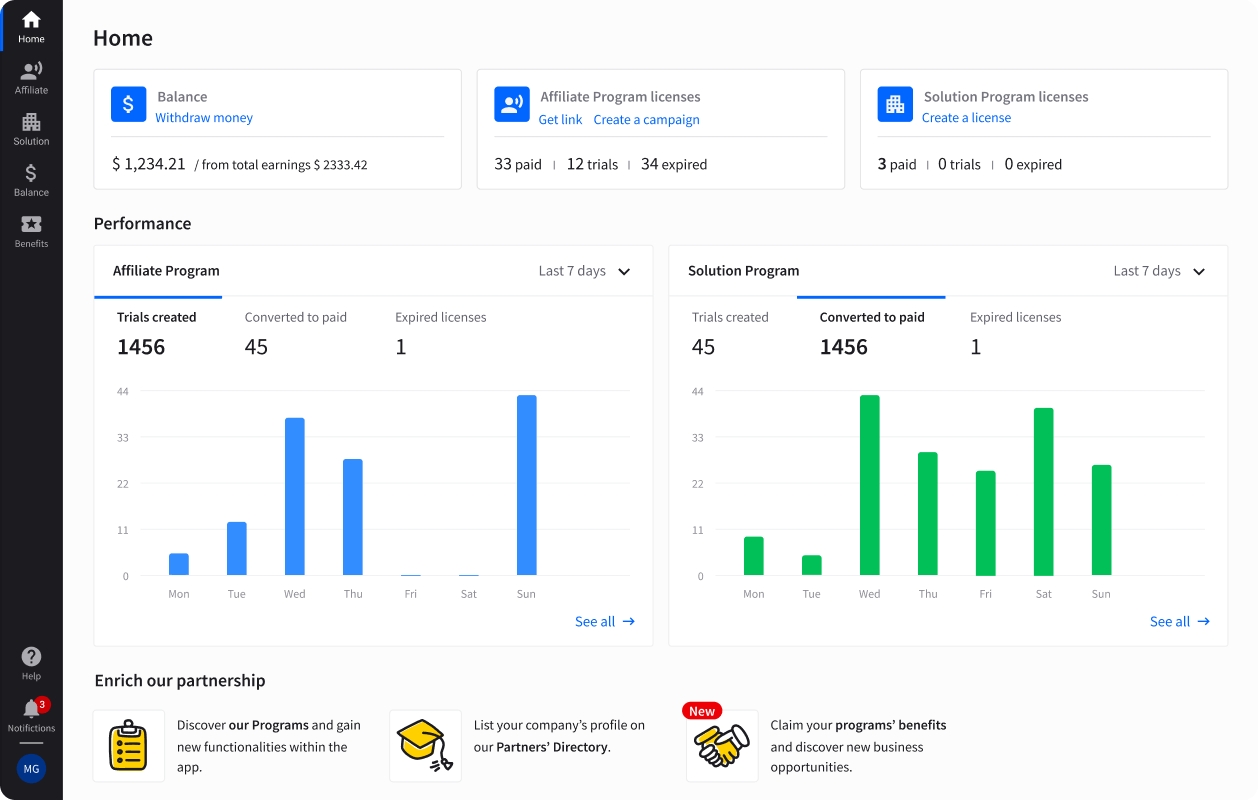Showing top 0 results 0 results found
Showing top 0 results 0 results found

SEO implementation starts early in your web design phase. And every seasoned SEO expert advocates SEO-friendly website design for stellar SEO performance.
Here is everything you need to know about SEO-friendly website design!
1. Plan for the mobile-first design
So, you might have long heard about the importance of responsive web design. But, what if I tell you that you need to change the approach to mobile-first design.
In April 2021, mobile devices (excluding tablets) accounted for 56.16% of total web traffic.
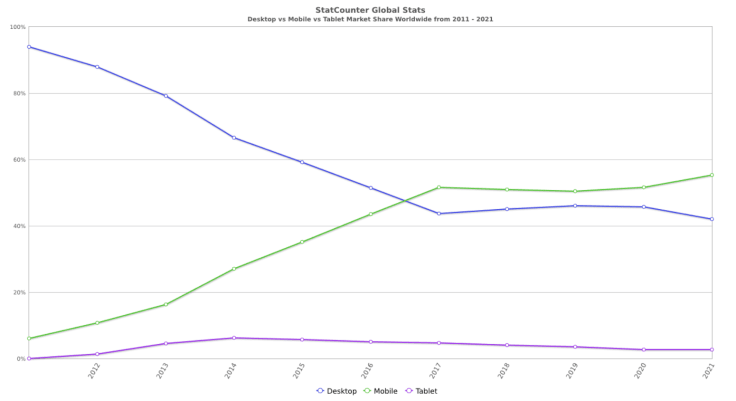
With that said, mobile devices are likely to source more than 50% of traffic on your site. And therefore, search engines consider mobile-friendliness as a crucial SEO parameter.
In fact, Google already follows a mobile-first indexing approach. And, unless you aren't looking for competent organic rankings, you must abide by mobile-friendly design.
The surest way to meet mobile-friendly standards is by designing for mobile-first. And then, you can take care of the desktop design.
2. Research and target the right keywords
As you further commence creating the content for your website, you need to define the right keywords. These keywords reflect the search terms your target audience uses to search for businesses or offerings similar to yours.
The first step is to define the target audiences for your business and their interests.
You can do this by:
- Creating several buyer personas of your target audience
- Analyzing the interests of your target audience by the content, they search online
- Getting insights into the user interests by the content they post on the web
Based on the above insights, you can search and target the right keywords for your business. In tandem, the keywords must have been relevant to your offerings and display the right intent.
Some tools that can assist you with your keyword research include:
- Google Keyword Planner (free)
- Paid tools like SEMRush and Ahrefs (These tools also offer competitor keyword research)
Here is a glimpse at the suggestions for “keyword research” keyword using keyword planner:
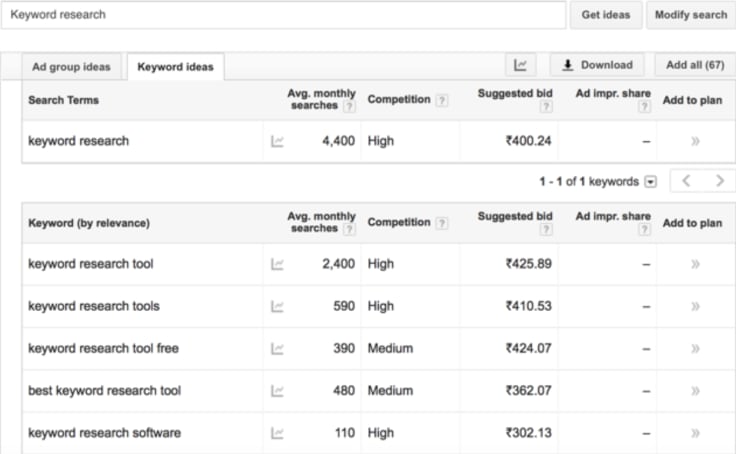
Moreover, you must also include long-tail and LSI keywords in your content. These keywords add specific intent or context to your content. Thus, helping your content rank for specific long-tail queries.
You can find these long-tail and LSI keywords by:
- Using tools like LSIGraph, KeywordTool.io, etc.
- Using Google Autocomplete, Google Related Searches, etc.
- Drawing keywords from user FAQs and user reviews.
The simplest way of searching LSI keywords is using Google Autocomplete. Below are some LSI keywords for “web development.”
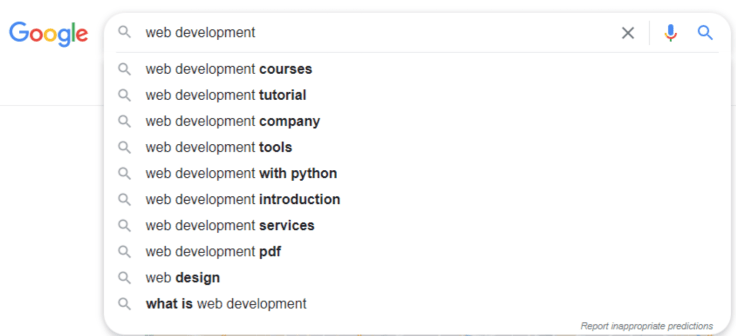
The next step is to sprinkle the sorted keywords smartly in your content.
3. Ace the right URL structure
Have ever paid attention to the URLs that dominate the top search engine rankings?
Those of you who have put a thought here know that Google likes a well-structured URL.
You might never see a bad URL structure, like the one shown below, rank in the SERPs.
An example of an unorganized URL structure looks like this:
- http://www.example.com/page.aspx?ID=100834fW
Such a URL doesn't say anything about the hierarchy of the site. Moreover, the URL doesn't hint at the destination that it targets. This is most likely to off-put the search engines, and these URLs will have a lower CTR.
Therefore, you must put good thought into crafting the correct URL structure.
An example of a thought-out URL structure is:
Here is an Example for an organized URL structure from Snapdeal.com:

This URL helps the search engine and the user understand the hierarchy of the site. Moreover, the URL displays the target destination page. This enables search engine bots to easily crawl to this page.
A well-structured URL, like the one shown above, also exudes trust. And users are more likely to click on such URLs as it hints a genuine destination.
Google Search Console also offers a useful feature to inspect your URL's aptness.
If your URL is not apt, Google crawlers will find it hard to access and index your webpage.
You just need to add your page URL, and if your URL is apt, the tool will display a green checkmark.
You can see it in the image below:
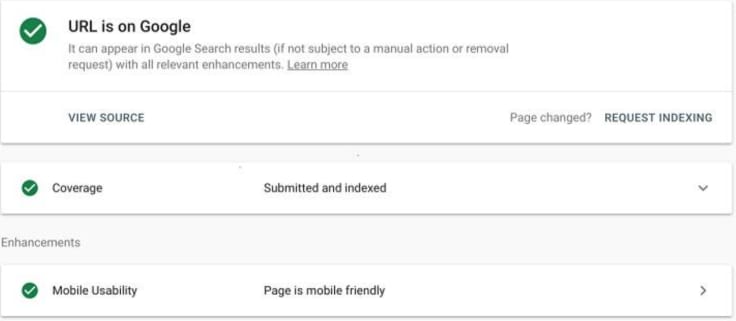
4. Weave the right UX with header tags and right content structure
Google strongly abides by its goal to deliver the best answers to a user's query. And so, it prioritizes the websites that offer an impressive user experience to the real searchers.
Meanwhile, header tags are crucial for crafting the right user experience. You need to define the right header tags to create an organized content structure.
A user finds it convenient to skim content that has an organized content structure. Moreover, this also helps search engines comprehend the content structure of a page.
The H1 tag represents the Page Title. It must include your page's focus keyword and the page's theme. Therefore, users (and Google) must know your page's context via your H1 tag or Title tag.
The other header tags (H2, H3, H4…) must also include the long-tail keywords of your page. This practice helps your page perform better in the SERPs for these keywords.
Moreover, you must use your smaller header tags smartly to increase the readability of your content.
Especially when mobile users prefer skimming your content, you cannot keep them bogged with long paragraphs.
So, you must use informational and relevant sub-headers to improve their experience. It can resolve a user's query faster, and it will keep them hooked up on your content.
You can also expect improved user metrics, which further adds to your SEO performance.
5. Create informative and eye-catching meta tags for high CTR
Your meta tags include the meta title and the meta description of your page. These tags are visible in the preview snippet or the listings of the page in the SERPs.
And these are the first things a user sees when he comes across your listing in the SERPs. With that said, these tags must be informative and catchy to offer a high click-through rate.
Both your meta title and meta description must include the focus keyword of the page. And they must allow the search crawlers and users to understand the context of the page.
Often, a meta title (or the SEO title) is the same as the web page's title tag (H1). This helps establish trust for the searchers. And they get to witness a consistency between the listing and the page content.
Moreover, the meta title must be SEO-friendly as it has an impact on your page's SEO.
Meanwhile, the meta description must be informative, and it summarizes the context of a page. A genuine and catchy meta title increases the CTR of a listing in the SERPs.
Here's an example.
You prepare a guide on off-page SEO tips, and now you want to create a meta title for it. So, you need to include your focus keyword (off-page SEO) in the meta title. And ensure that the title convinces the audience to click through your SERP listing. Some catchy meta titles can include:
- Off-page SEO Tips to Ace Google Rankings
- Winning Off-page SEO Tips No Marketer Will Tell You
- Hack Off-page SEO with These 10 Tips
- Your Secret Guide to Off-page SEO: Start Ranking Today
The ideal meta title length is less than or equal to 55 characters. And the character length of your meta description must not exceed 155 - 160 characters. Anything above these length standards is cropped in the preview snippet.
Here is an example of the best usage of Meta description from Apple.com.

6. Define simplified site architecture with proper internal linking
The simpler is your site architecture, the lower is your site's crawl difficulty. And it affects your site's optimization.
Furthermore, neither bots nor users like to navigate through a complicated site architecture.
An unorganized site structure has issues like:
- Unsynchronized crawling and indexing of your web pages and new content pages
- Pages that lie lower in the site hierarchy are often left unindexed
- Users find it inconvenient to navigate through your site
- Increased bounce rate and exit rate on your site
- Poor rankings in the SERPs
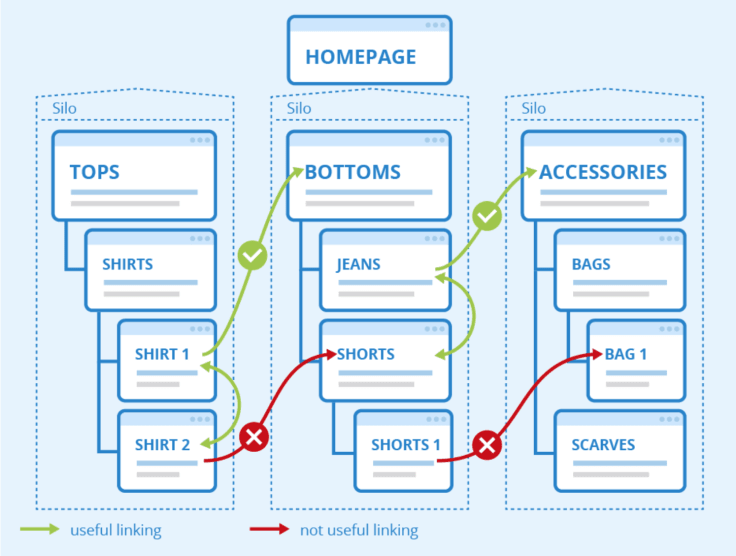
So, how do you define a proper site structure?
Site architecture pertains to the hierarchy you follow within your site and the internal linking. Getting these two parameters in place benefits your site's SEO and user experience.
Some ways to optimize site architecture include:
- Avoiding the practice of placing pages too deep in the hierarchy
- Eliminating the use of orphan pages
- Defining a horizontally-spread site structure will less crawl depth
- Employing a simple internal linking structure that users can use to navigate through the site
- Using informational and keyword-based anchor texts to make internal links accessible
- The internal links must pass the link juice to important pages on your site.
7. Optimize your content for the E-A-T algorithm and readability
It is the content that fuels your SEO, branding, marketing, and your presence online. With that said, you need to put plentiful thought into your content strategy.
It must be in line with the interest of your target audience and your brand offerings.
Moreover, Google leverages the E-A-T rank factor to rank your content. This factor refers to the Expertise, Authoritativeness, and Trustworthiness of your content.
Take a look at this example from Northwest Pharmacy.

Expertise: Does an expert in the niche has created the content? Does the content exude the right value for your audience?
Authoritativeness: Google loves content that is highly reliable and comes from an authoritative source. It tries to source the best and most authentic answer to every query.
Trustworthiness:
Google scrutinizes if your content is purely unbiased and the information is trustworthy.
Furthermore, Google has long been emphasizing the readability of content. It wants businesses to create content for humans before considering the SEO bots.
This means you need to put good thought into crafting the right UX through your content. The right brand colors, font styles, font sizes, and design plays a crucial role in improving readability.
And this readability has an impetus on the user metrics of your site. It further influences the site's SEO performance.
You must make sure both SEO crawlers and users understand your content and its relevance. Hence, you must lead by creating a well-defined content structure.
Moreover, crawlers are not able to comprehend the video and image-based content. And so, you must add transcripts along with such content to make sure it adds to your SEO benefit.
8. Earn abounding inbound links to your site
A significant part of your off-page SEO strategy is gaining abounding backlinks for your site. These backlinks must be from high authority and relevant sources.
And both the number of backlinks and the quality of the backlinks influence your SEO.
As you direct your efforts towards link building, you must understand that:
- A single backlink from a high-authority site is better than hundred low-quality links.
- Natural, content-based links offer higher value than any paid backlinks.
There are several effective ways of attracting backlinks to your site. These include:
- Analyzing the competitor's backlinks to find link-building opportunities.
- Producing cornerstone content for your site that everyone wishes to link to
- Creating niche-based expert blogs and promoting them to the relevant audience for attracting links.
- Looking for link gaps in Wikipedia and leveraging the opportunity by providing relevant links.
- Creating other marketing materials like infographics, videos, pdfs, etc., for earning links.
Once you start gaining backlinks, you must plan to share the link juice to important pages via internal links.
9. Compress images and add descriptive alt text
Your website performance and load time have an impact on your site SEO and conversions.
As per Deloitte's survey, a decrement of 0.1 sec in load time can upsurge conversions by 8%.
And what adds up here is that image optimization is crucial for your website performance.
So, you must optimize your website images without compromising on their quality.
These images are crucial for your user experience and your SEO. And the right way to leverage your images for SEO is by adding Alt Text.
You do not need to put special thought into crafting your image Alt Text. But, you need to add a simple description of the image in the Alt Text.
A descriptive Alt Text helps you with:
- Ranking in the Google Image Search for the keywords in the Alt Text.
- Help understand the context of an image if it fails to load appropriately.
- One can read out this description to a visually impaired user to help him understand an image.
Google considers Alt Text as an important practice, and so must you!
Let's take a look at an example from Mi.com.

10. Add an XML sitemap to your site
While you tick-mark your SEO checklist, you must not forget to add an XML sitemap to your site.
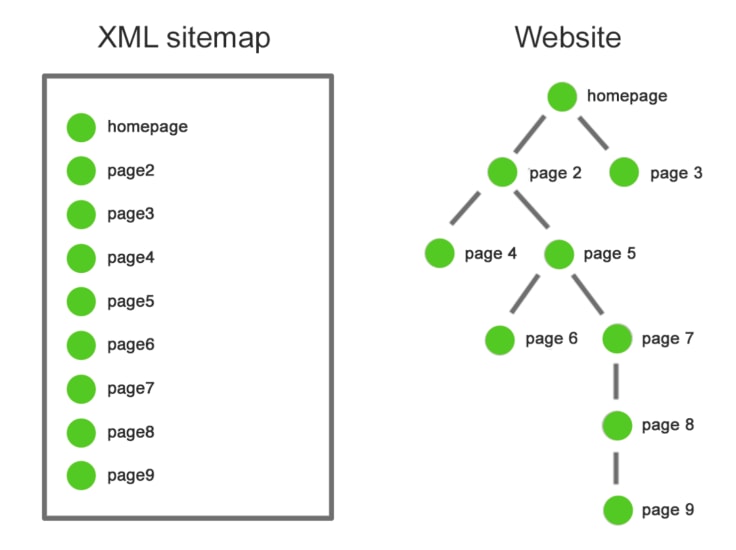
The XML sitemap helps the crawlers comprehend the content and media of your site. You can use an XML sitemap to inform the search engines about the important web pages.
And it helps crawlers to index your site, pages, and content better in line with your strategy.
A sitemap also tells Google when the content was last updated and if it requires indexing. Moreover, it also has instructions regarding translating a page based on the access location.
11. Produce unique content and use canonical tags
It goes without saying that you must produce unique content. And the originality of your content holds great value for your SEO.
Google might not actively punish you for adding duplicate content to your site. But, it condemns content duplication and considers it as a black hat SEO practice.
Moreover, duplicate content is less likely to get indexed. Thus, making it futile for your SEO.
On the other hand, original, high-quality content adds significantly to your SEO performance.
However, you are likely to come across content sections on your site that you may need on several pages. And in this case, you must use canonical tags for these sections.
So, the canonical tag points at the original (unique) section and informs Google about the same.
And the other sections are considered the variations of this original section.
Google now indexes only the original section, and the other variations aren't indexed. This saves your content from the duplication penalty.
12. Limit the website to only valuable pages
It might be the right time to waive off a common misconception that more pages source more traffic.
Instead, you must try to limit your site to only valuable pages.
More site pages will only add more issues to your site. If you have 10,000 pages on your site, they would be harder to manage. And you are more likely to violate SEO best practices with issues like:
- Content spinning
- Thin content on several pages
- Unorganized site architecture
- Increased probability of Google Panda penalties
Instead, Google itself advocates smaller websites with quality pages over larger sites.
Smaller websites allow you to dedicate more time to optimizing specific pages. And you can easily abide by the best SEO practices and content quality standards.
Benefits of designing an SEO friendly website
1. Cost-effective leads and conversions
SEO is cost-effective as compared to its popular counterpart PPC (pay per click). The former offers you free listings in the SERPs without paying for search ads.
Instead, you follow an SEO strategy to optimize your site content and build backlinks. Moreover, you need to manage your presence and reputation online.
These efforts help Google recognize and index your site and pages in its database. And the search engine then retrieves your pages as organic results for relevant queries.
With that said, you only need to invest money and efforts in optimizing your site for search engines.
Once you have a commendable search engine presence, you draw relevant traffic. And this traffic draws you leads and conversions.
As per statistics, 40% of all the leads earned by businesses online are via organic traffic.
2. Growth in site traffic
A BrightEdge report says, 53% of all the traffic on a website comes via organic search results.
So, SEO-friendly website design helps you increase your organic rankings. Moreover, as you optimize for the right set of keywords, you can expect relevant traffic.
The right targeting further helps you increase conversions through qualified traffic.
SEO, unlike PPC, sources your traffic without any charge.
For instance, sourcing 10K traffic on your website from PPC might cost you $30K if you pay a minimum of $3 per click.
Meanwhile, your SEO investment will be far lower than PPC (for the same traffic size).
Therefore, SEO can help you increase your site traffic without investing a huge sum on ads.
3. Top rankings adds to brand awareness and credibility
We, as consumers, are driven by social proof. And a majority of our purchase decisions are influenced by it.
Therefore, businesses readily invest in social reputation management efforts. And the businesses with good social proof achieve higher sales and conversions.
Having said that, users consider your SEO rankings as important social proof. Just take a look customer success stories section from LiveChat ;)
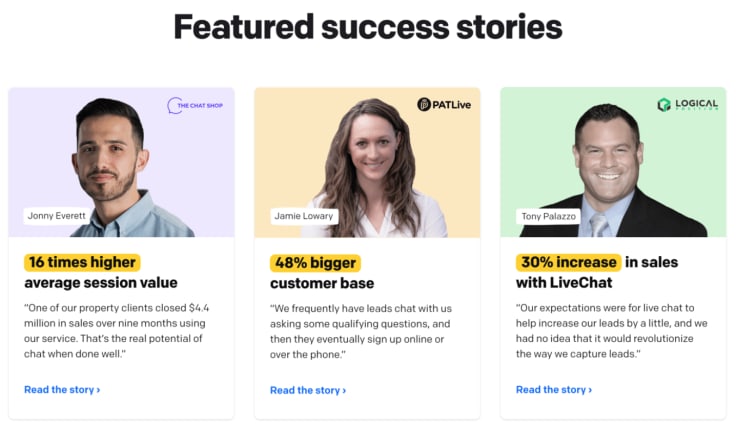
An SEO-friendly website can rank higher in the SERPs, and this will add to its credibility.
Thus, helping them gain a high conversion rate from the organic traffic on the site.
4. Sustainable (non-volatile) results and benefits
PPC is about buying a rented space from Google to show your listings in the search results. And this rent is paid with every click on your PPC ad.
Your PPC listings disappear or cease to exist as soon as your budget expires.
Meanwhile, your SEO rankings are sustainable. You might require a bountiful effort to win good SEO rankings, but these ranks are not volatile.
Even if your SEO team goes for a week's vacation, you wouldn't see a major drop in your rankings.
Moreover, the top rankings in the SERPs adhere to their positions longer. More and more businesses wish to link to these pages for reliable information.
And the authority of these pages regularly grows with time. Thus, helping them cling to the top positions of the SERPs even tighter with time.
Website design tips & SEO FAQ
Q1. How can website design impact your SEO performance?
Your website design has an immediate and first-hand impact on your SEO performance.
Your website design forms your website architecture as well as its user experience.
If you do not optimize your site architecture, crawlers will find it hard to index your site.
Moreover, your website will fail to rank with an unsynchronized internal link structure.
If your site design does not include on-page SEO considerations, you will fail to rank online.
Further, a proper website design is crucial to crafting the right user experience. However, if your website design falls short of the UX it offers, it will impact user metrics.
You can witness a high bounce rate, lower session time, and no interaction on your site. And these low user metrics parameters are most likely to affect your SEO.
Q2. What are some definite ways to make your website SEO-friendly?
The first thing almost every business needs is an SEO-friendly website. The second is, of course, leads and conversions!
So, here are some definite tips to make your website SEO-friendly:
- Plan your website's design for mobile-first indexing.
- Research and analyze the interest and search behavior of your target audience.
- Use the right keywords to rank for relevant search terms.
- Optimize the content for its value, authoritativeness, and expertise.
- Put good thought in your URL structure and add an XML sitemap.
- Create and add descriptive Meta Tags that include the focus keywords of the page. Moreover, the Meta title and Meta description must attract high CTR.
- Grow the authority of your website by earning high-quality backlinks from relevant sites.
- Create highly readable content pages with the use of optimized images and header tags.



